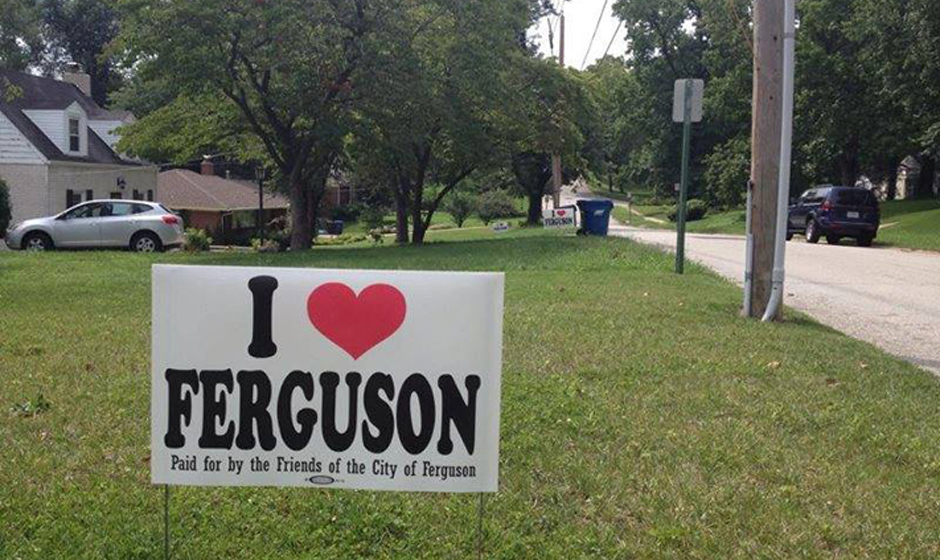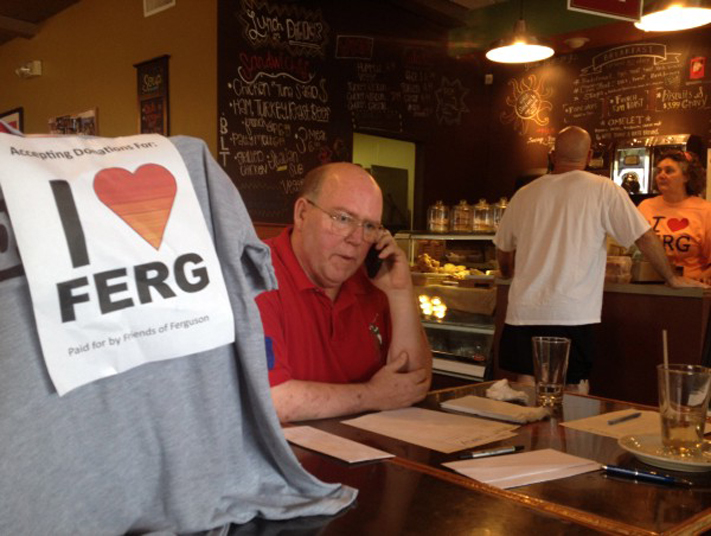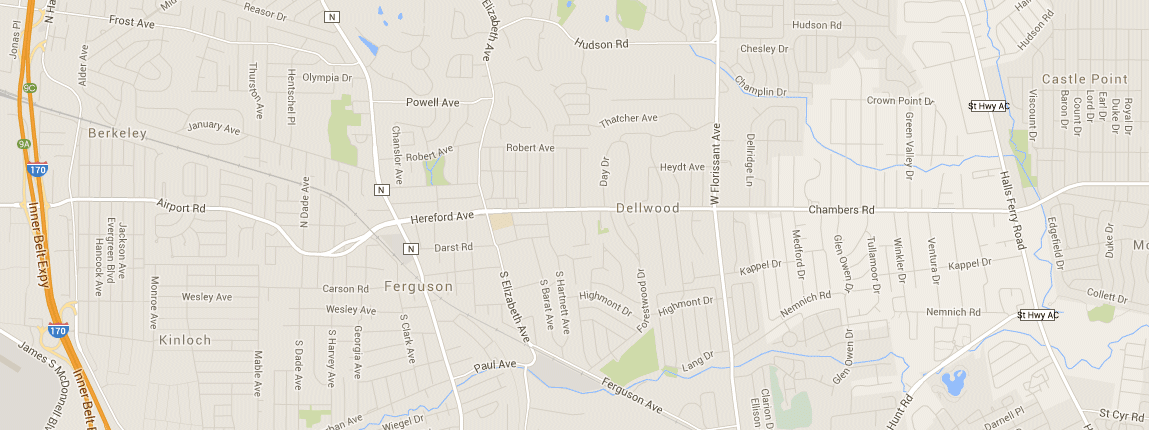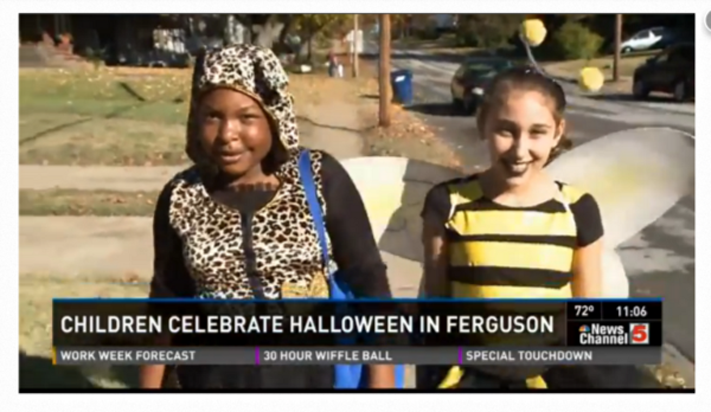They say they’re worried “about opening their doors…as well as for (their) children’s safety…
The white people of Ferguson are scared of Halloween. So scared that they cancelled it, and then rescheduled it, and then confined its alternative to a certain part of town. They say they’re worried “about opening their doors…as well as for
“We don’t know how or when the recent unrest will come to an end,” wrote Brian Fletcher, a local white man, in an email announcing his plan to “move Ferguson’s celebration of Halloween … [r]ather than the children Trick or Treating throughout the entire city.”
“We’re not going to let people from the outside paint a picture of the Ferguson that we’ve loved for 120 years that is inaccurate,” he said in August.
For several weeks in August, Fletcher sat at a table at a local coffee shop in a white part of town where locals, virtually all white, stopped by and handed him $20 bills. He and other volunteers collected tens of thousands of dollars and used the money to buy “I ❤ FERG” t-shirts and lawn signs that volunteers shoved into yards.

A photo from iloveferguson.com of an “I ❤ Ferguson” lawn sign.
Their latest endeavor—an alternative Halloween to protect children from “unrest”— sounds very nice. But here’s the thing: by unrest, the organizers of the alternative Halloween really mean protesters. And by protesters, they really mean angry black people.
The trick-or-treat map that I ❤ Ferguson handed out Sunday routed families through the Old Ferguson East Neighborhood. The group said on its website that it chose the area for its “central location” and the concentration of churches. But the neighborhood is one of the only places in the city that still resembles the Ferguson of 120 years ago — before there were any black people there—when Fletcher’s people started ❤ing Ferguson.
In the map here, the maroon indicates the parts of Ferguson and surrounding St. Louis County cities where black people live. The little yellow and orange blocks, those are where Ferguson’s white people live. And the pumpkin? That’s where I ❤ Ferg Halloween held it’s Pumkin Walk— as in, children and their parents walking past Old Ferguson East’s big wooden churches where white people pray and the private schools where white kids learn.
A map of ferguson and surrounding St. Louis County cities, roughly color-coded for racial makeup of the blocks.
To be fair, in its press release, I ❤ Ferguson announced that there would be buses picking up children from neighborhoods including Canfield Green, the all-black housing complex where Michael Brown was shot and killed by police officer Darren Wilson. The $5000 in candy that a CVS in town donated to I ❤ Ferguson (which can happen now with ease since the group somehow got its non-profit status fast-tracked by the county) was gobbled up by black kids and white kids alike.
But if I ❤ Ferguson’s history is any sign, the commitment to equality is thin.
One evening in August, just a few hours after Fletcher was finished selling “I ❤ Ferg” shirts at the Corner Coffee House, the police began firing tear gas at African-American grandmothers and children three hours before they’d been told the curfew would begin. Fletcher didn’t say much about this, but a couple of days later his group held a town meeting to talk about the city’s problems. A reporter who attended said just three, yes three, of the hundreds of people in attendance were black. It’s unclear why these white people didn’t attend one of the many public meetings convened by black activists in other parts of town.
Fletcher has a history of being more concerned with optics than equality. When Fletcher was mayor in 2010, residents raised concerns about rising evictions and high crime in low income housing developments like Canfield Green Apartments. “Fletcher seemed alarmed by a potential public relations problem swelling on the horizon,” The Post Dispatch reported this month.
I don’t want to get in a situation … where every time you turn on the news
there’s a shooting going on at that apartment complex,' he said.…
'We need to cut that off. We’ve already had some incidents.…
It hasn’t been as high-profile, but I don’t want them to be.'
Among the things that makes I ❤ Ferguson’s public relations campaign so hard to take is its thick reliance on euphemism, a tool of constructed blindness, when talking about black people.
“We wanted people to see what Ferguson was really like,” one I ❤ Ferguson volunteer, a middle aged white woman, told the local NBC affiliate. “We wanted them to see how many things we really do for the residents of Ferguson.”
Translation: “The people who own this town — the whites — wanted the blacks (‘how does it feel to be a problem?’) to see how many things we really do for them.”
For about six decades, Americans, all of us, have had it driven into our minds that if we all just get along, if white people just see race a little bit less, act a little more charitably toward the “underserved,” we’ll fix the race problem. That’s a lie. Love and understanding do not precede justice. Justice itself is something like public love. White people’s inability to see this relies on an active ignorance about the way that race and inequality are woven deeply into the systems, big and small, in which we live. For 120 years, Ferguson (and the country) has built that inequality, through policies and laws, and denial.
“When you don’t try to integrate yourself into this diverse city,” Maria Chappelle-Nadal, a Missouri State Senator who is black and represents parts of St. Louis County, said in an interview, “you get real comfortable and blind.”
‘So what do you do’ white people of Ferguson? Here’s one piece of an answer. First, perhaps stop trying to reassert your power, benevolent as you may think that it is, over the lives of black people.
Then, maybe get behind the effort that’s well underway to unseat white power. MSNBC reported this week that the police chief is about to lose his job. There’s a suggestion that St. Louis County will assume control over the police force. You could demand that they hire black officers and that they curtail the regressive use fines on poor people to fund city programs. Black activists in Ferguson are calling for the immediate arrest of Darren Wilson, and for the appointment of a special prosecutor. Perhaps join those calls. And demand that your city council (which better become blacker, and soon) assess every policy it passes to make certain it’s not deepening racial inequality.
Stop playing blocker for the status quo. Get behind the “wholesale change” in Ferguson that Attorney General Eric Holder called for yesterday. And don’t pretend you know exactly how to make that happen. You’ve been in control of this city for 120 years and look where that’s got you. Do a little more listening—you’re surrounded by an increasingly organized group of black activists crafting a future for your city whom you can listen to. Do a little less talking, white guys.
Then, once the city begins to become a bit more like a democracy, invite each other to your Halloween walks, sure. You say, you’re trying to “begin making more relationship building with … citizens throughout the whole of Ferguson,” (the white woman volunteer told the news), but the thing is, Ferguson isn’t yours to share.
And up the block from the two little girls in their Rockwellian scene, was a white family, a mother and father and two sons. The youngest son wore a black and white striped prisoner costume. It’s a heavy kind of blindness that lets white parents dress their son this way in a city rattled by protest over the criminal justice system’s treatment of black men.
Old Ferguson East Neighborhood is one of the few neighborhoods that scarcely changed. It stayed mostly white the whole time. And it’s the one place, apparently, that those who ❤ Ferguson feel their kids are safe.
White Guys Talking What it sounds like. Some white guys talking.
This piece was republished by EmpathyEducates with the kind permission of Medium. We thank Medium, Culture Club Curator, Felicia Megan Gordon, and the Author, White Guys Talking Follow @WhiteGuyTalking on Twitter.















Leave A Comment